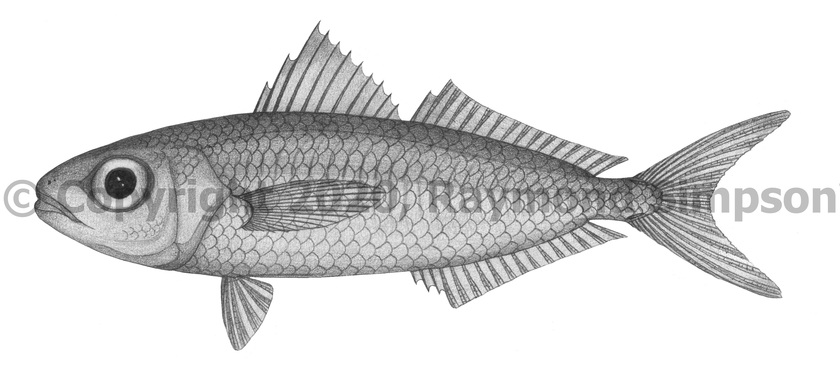
Common Name
Silver Rag Driftfish
Year Described
Fowler, 1930
Identification
Dorsal Fin: XI, I, 13-16
Anal Fin: III, 12-16
Pelvic Fin: I, 5
Pectoral Fin: 20-23
Gill Rakers: 25-30
Vertebrae: 30-31
Lateral Line Scales: 30-45
Body fusiform and cylindrical in cross-section. Head large with slightly oblique, terminal mouth. Snout short. Eye large. Upper jaw short and covered by pre-orbital bone. Very small teeth along jaw but not on palatine or vomer. Edge of opercle smooth. Caudal peduncle short and cylindrical with two fleshy keels on each side of caudal fin base. Dorsal fins barely separated. Second dorsal and anal fin of similar length. Caudal fin forked. Pectoral fins reach base of dorsal fin. Pelvic fins under base of pectoral fins. Dorsal and pelvic fins retract into groove. Lateral line high on body and ending before caudal peduncle. Head and lateral line scales only moderately developed. Scales cycloid; covering body forward to top of head. Two scale rows between dorsal and lateral line. Scale patch on top of head only reaches forward to level of anterior edge of the pupil.
Color
Bicolored blue-black above and silvery below. Fins dusky above and pale below. Peritoneum pale.
Size
Maximum size to 25cm SL.
Habitat
Most commonly caught in shallower water (70-200m), but juveniles are taken toward the surface. Benthopelagic.
Range
Widespread from Maine to Uruguay, including the Gulf of Mexico and Caribbean Sea.
References
Carpenter, K.E. 2002. The living marine resources of the Western Central Atlantic (Vol. 3, pp. 1375-2127). Rome, Italy: Food and agriculture organization of the United Nations.
Horn, M.H. 1972. Systematic status and aspects of the ecology of the elongate ariommid fishes (Suborder Stromateoidei) in the Atlantic. Bulletin of Marine Science, 22(3), 537-558.
Other Notes
This species and Ariomma melanum are closely related but can be distinguished by lateral scale counts, the forward extent of the scales on the head, the development of the sensory system on the head, peritoneum color, and depth of capture (Horn, 1972).